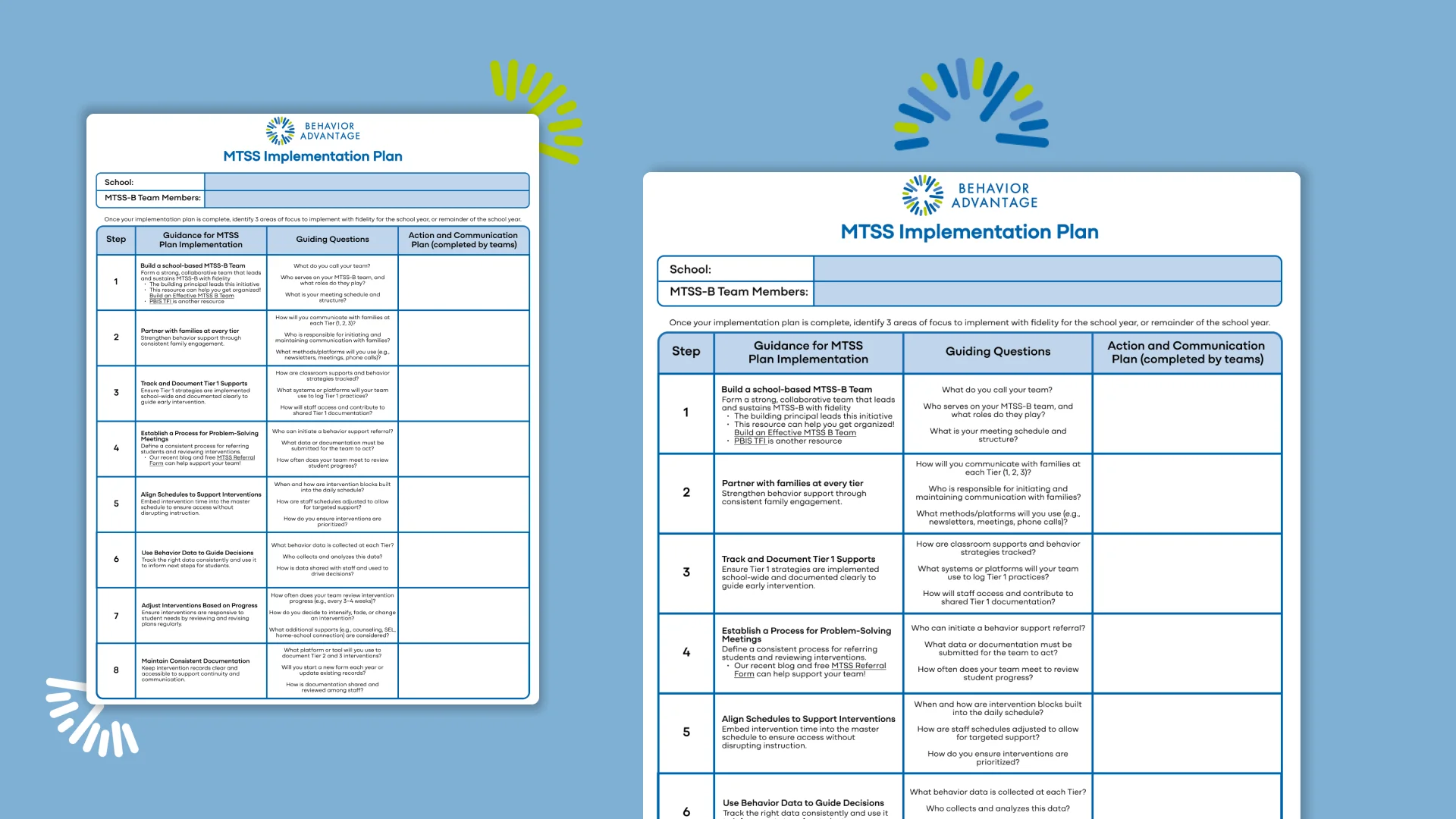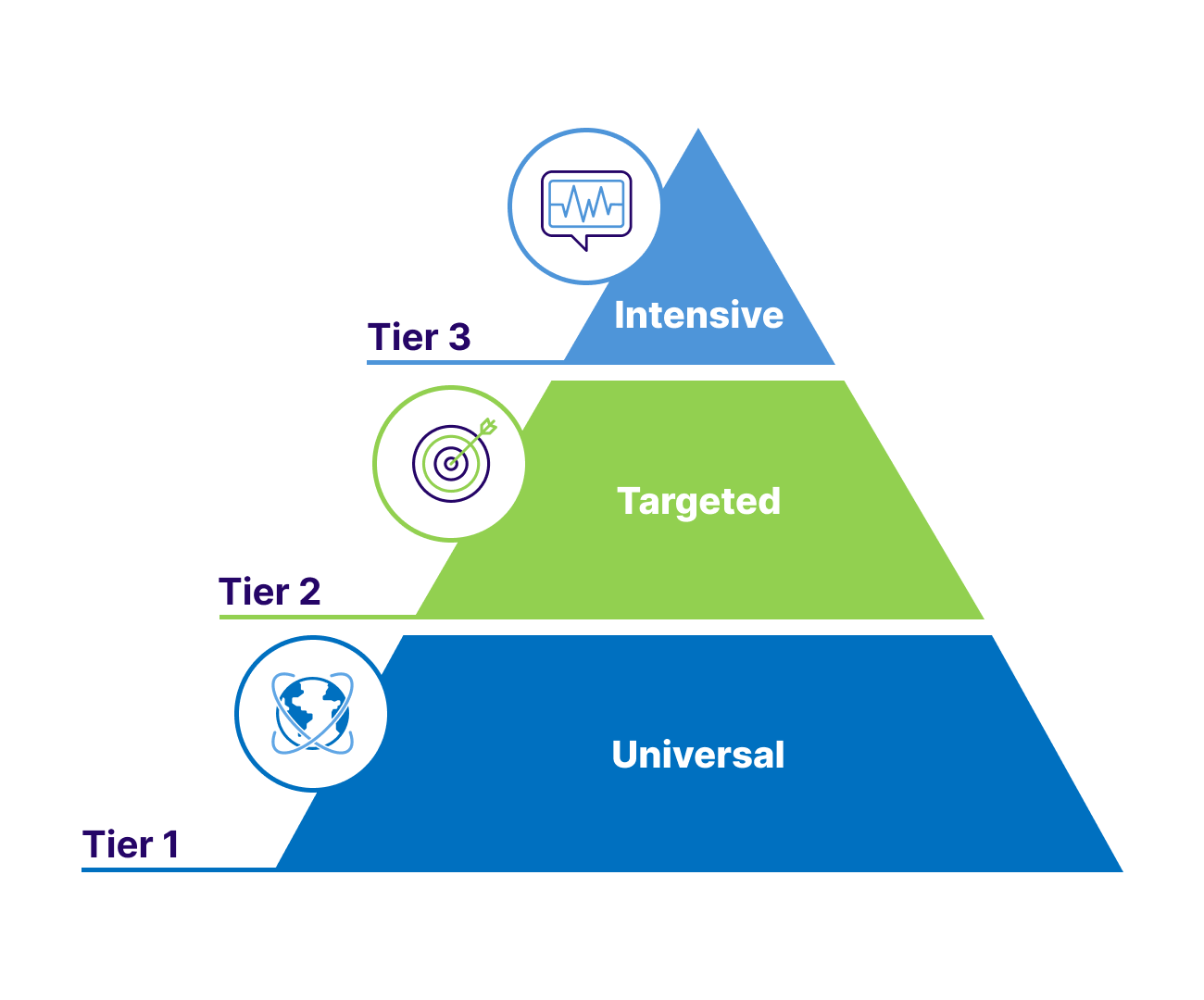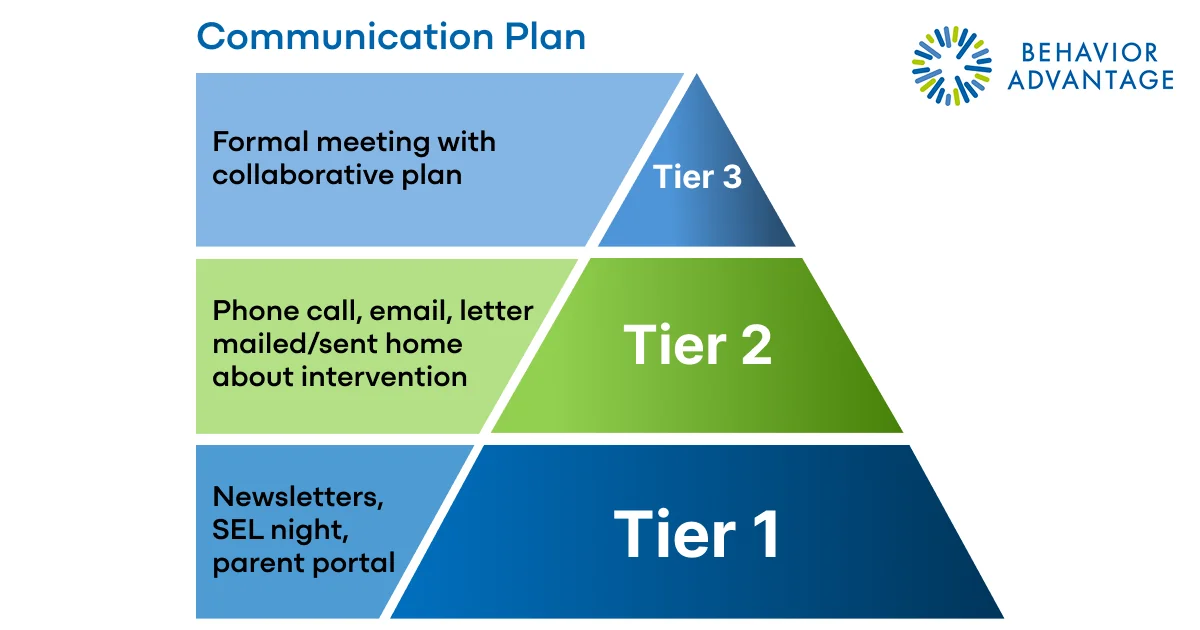The success of behavior support in schools depends on systems—not just strategies. The Multi-Tiered System of Supports for Behavior (MTSS – B) offers a framework to organize supports in a way that’s proactive, data-driven, and inclusive.
This guide walks you through each key decision your school team needs to make an MTSS implementation plan — while also giving you real tools, clear tips, and free online resources to help your MTSS-B system not just function, but actually make a difference.
If you’re just getting started on your MTSS-B journey, Behavior Advantage offers resources that bring clarity to the complex — and often emotional—work of understanding behavior within an MTSS framework. This recent blog, Understanding Behavior in MTSS, is a great place to start!
Download our free MTSS Implementation Plan Template

What Is MTSS-B and Why Does It Matter?
When we think about supporting student behavior, it’s easy to fall into the trap of only reacting when something goes wrong. But a strong Multi-Tiered System of Support for behavior (MTSS-B) flips that script. It’s a proactive, structured approach that helps students build the social, emotional, and behavioral skills they need to succeed—not just in school, but in life.
MTSS-B organizes student behavioral support into three tiers, visually represented by a pyramid that illustrates the scope and intensity of support. You can learn more about MTSS Pyramid in Behavior in the recent Behavior Advantage Blog.
- Tier 1: Universal supports all students receive, such as schoolwide expectations and SEL instruction
- Tier 2: Targeted support for students needing extra practice or coaching
- Tier 3: Intensive, individualized support based on student-specific needs
The system isn’t just about managing behavior—it’s about teaching it, monitoring progress, and making sure our interventions actually work. With the right team, clear processes, and data guiding decisions, MTSS-B creates a school climate where students feel supported, not singled out. This approach helps educators spend less time putting out fires and more time helping students grow.

Understanding MTSS-B—and the positive impact this systematic approach can have on both learners and educators—lays the groundwork for implementing an MTSS plan that is purposeful, consistent, and responsive to student needs.
Let’s break down the key components of a strong MTSS-B implementation plan that can help you successfully launch and sustain an MTSS-B system in your organization.
Core MTSS-B Implementation Plan Features
In this section, we’ll explore the essential components of successfully implementing your MTSS-B system. These practical steps—combined with our MTSS-B Implementation Plan Guide—will help you and your team build a strong, sustainable framework to support positive behavior in your school.

✅Build a School-Based MTSS-B Team
The strength of MTSS-B starts with the people leading it and the systems they put in place. It takes more than just good intentions—effective implementation depends on strong, collaborative teams who understand the framework and stay committed to using it with fidelity. Clear processes, regular data review, and open communication help ensure that every student gets the right support at the right time. When leadership is focused and systems are tight, MTSS-B doesn’t just work—it thrives.
Some considerations for your team include as you consider your MTSS implementation plan are::
- What do you call your team?
- Who is on your team? Set up a predicable meeting schedule
- Download our free guide, Building an Effective MTSS Team for practical tips to create a strong, collaborative team that supports student success to get started today!
✅Partnering with Families at Every Tier
Behavior support is strongest when families are engaged as active partners in the process. When schools take the time to build trust and keep communication open, families are more likely to reinforce expectations and strategies at home. This consistency between school and home creates a more stable, supportive environment for students to practice and strengthen their skills. Simply put, when educators and families work together, behavior support becomes more effective, lasting, and meaningful.
It’s important that your staff understand the expectations around family engagement and their important contributions across all 3 tiers. Here are some ideas on what you can communicate with your teams:
- What methods of communication will you use at each Tier (e.g. digital platforms, phone calls, conference, emails)
- Who is responsible for updates (teacher, case manager, counselor)

✅Track and Document Tier 1 Supports
A solid MTSS implementation plan starts with tracking and documenting Tier 1 supports effectively. By carefully recording what strategies work at the universal level, schools can reduce unnecessary referrals and identify patterns in student behavior early on. This process not only strengthens Tier 1 interventions but also ensures that Tier 2 and Tier 3 supports are targeted and efficient. For practical tools and guidance on documenting Tier 1 practices, check out resources like PBIS School-Wide Supports to help your team stay organized and data-driven.
Examples of supportive Tier 1 data include:
- Classroom behavior logs and data
- Checklists for behavior supports (e.g. seating changes, self regulation tools)
- Shared MTSS folders or platforms
✅Establish a Process for Problem Solving Meetings
A strong MTSS implementation plan includes a clear, consistent process for behavior referrals and follow-up. Your team should know exactly who can initiate a request, what information is needed—like behavior data and intervention history—and how often the team meets to review cases.
Considerations for your MTSS Implementation Plan should include:
- Who initiates the problem-solving request (teacher, specialist, administrator, etc.)
- What information must be submitted? (behavior data, intervention history)
- How often the team meets (minimum of monthly meetings, more frequently for Tier 3 students)
Want a ready-to-use structure? Check out our MTSS Referral Form Guide and Free Download to keep supports moving forward.
✅Align Schedules to Support Interventions
For MTSS implementation to be effective, schools must align schedules so interventions are built into the day—not squeezed in as an afterthought. Thoughtful planning ensures that every student who needs support actually receives it, without disrupting core instruction.
✅Use Behavior Data to Guide Decisions
An effective MTSS implementation plan relies on behavior data that’s consistent, accurate, and actually used to make decisions. Every team member should understand what to track, how to use that data meaningfully, and be able to support others in doing the same. Here are a few examples of data sources you can rely on:
- Tier 1: Informal observations, class tracking sheets
- Tier 2 & Tier 3: Behavior charts, Office Discipline Referrals (ODRs), and targeted progress monitoring tools
✅Adjust Interventions Based on Progress
- MTSS interventions aren’t meant to stay static—they should shift based on how students are responding. Using a regular review cycle ensures teams stay proactive and data-driven.For example: Teams should meet every 3–4 weeks to evaluate progress and determine next steps
- Adjust intensity (e.g., more frequent check-ins, smaller groups, or decreasing intensity if the data supports it)
- Consider wraparound support (counselor, SEL curriculum, home-school connection, etc.)
Our Guide for Effective MTSS Meetings and Free Meeting Template can help streamline these conversations, making it easier to evaluate progress and decide on next steps with confidence.
✅Maintaining Consistent Documentation
Consistent documentation is key to making sure MTSS supports are seamless, even when staff or schedules change. When teams share clear records of interventions and outcomes, it reduces confusion and keeps student support on track.
Additional information you should include on your MTSS implementation plan include:
- Use digital logs organized by time.
- Decide annually whether to carry over documentation or start fresh with new plans
Final Thoughts: Progress, Not Perfection
Implementing MTSS-B doesn’t require perfection—it requires clarity, consistency, and collaboration. Focus on getting the foundation right: a strong team, clear roles, reliable data, and compassionate communication with families.
By following a clear MTSS implementation plan and using your district’s existing tools, your school can build a behavior support system that’s sustainable, responsive, and aligned across all tiers. A well-designed MTSS system helps ensure every student receives the right support at the right time.
Ready to take the next step? Reach out to us to learn how we can support your school’s MTSS journey.









